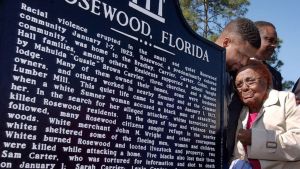
In this May 4, 2004, photo, living survivor of the 1923 violence in Rosewood, Fla., Robie Allenetta Mortin, is comforted by Florida Rep. Ed Jennings Jr. after he unveiled the Rosewood, Florida Historical marker at a dedication ceremony. (Photo: Doug Finger/AP)
By Lane Degregory
The Associated Press via Tampa Bay Times
The house needs a new home.
It might someday become a museum, so it can keep sharing its story of slaughter and survival.
It’s the last house in what once was Rosewood, a community of 300 people — mostly Black — who lived along State Road 24, the road to Cedar Key.
On Jan. 1, 1923, a White woman claimed a Black man had attacked her. Her lie inflamed the Ku Klux Klan. Throughout the week, a vigilante crowd burned down the town and killed five Black people.
“It’s a place that needs to be remembered,” said Lizzie Jenkins, 82, whose aunt escaped the massacre. “That house is part of who I am.”
In 1870, a post office and train depot opened in Rosewood, which officials named for its abundant pink cedars. Residents worked in lumber yards, turpentine mills and, later, at a factory that turned trees into pencils. Families built houses, churches, a school and a baseball diamond.
One store, owned by a White man, served the town. It sat near the railroad tracks, in the man’s three-story Victorian house with stained-glass windows, surrounded by 35 acres. When the shooting began, John Wright and his wife sheltered Jenkins’ aunt, Mahulda “Gussie” Brown Carrier, and other Black women and children, hiding them in their attic, closing them into a secret closet, lowering them into the well.
“If it hadn’t been for that store owner, all of them would have died,” said Jenkins. “He kept them safe for two days, until the sheriff could get a train conductor to move them. Most of the people got off the train at the first stop, which is Archer.”
They never went back to Rosewood.
For almost 60 years, people seldom mentioned the massacre. Then, in 1982, a St. Petersburg Times reporter wrote about it, and CBS news turned it into a national story. Director John Singleton made a movie, “Rosewood,” in 1997, and in 2004, then-Gov. Jeb Bush dedicated a plaque alongside the highway, right behind the John Wright house. Bullet holes now pock the metal. Florida’s Legislature also issued checks up to $150,000 to 10 people who could prove they lived in Rosewood in 1923 — the first time any state paid compensation to Black people for racial injustice.
Jenkins has been trying to save that house for 30 years. It went on the market in 2018, but she and her Real Rosewood Foundation couldn’t drum up the $300,000.
Fuji Scoggins, who had owned the house for 42 years, finally sold it in 2020, to a young clam farmer and his wife. They moved in that April, and Scoggins moved to Chiefland. Jenkins tried to convince Ian Stone to let the foundation buy just the house. Once he learned how much work it needed, he offered to sell it. But the group couldn’t raise the $100,000.
In July, Jenkins and three members of the foundation’s board went to see Stone again, hoping for more time to raise the money.
“His wife made us Kool-Aid and chocolate chip cookies on the porch, and we almost fell out of our chairs when he told us,” she said. Instead of selling John Wright’s historic home, the couple had decided to donate it.
But they want to keep the land to store boats and equipment, maybe set up a clam shop.
So now, the foundation has to find someone to shore up the old house and move it 35 miles down State Road 24 to Archer, onto a 29-acre parcel that Jenkins’ grandfather bought in 1904.
“We’re going to protect and shelter that house,” she said, “like it sheltered the Rosewood survivors.”
She envisions a memorial, history wall, library and retreat center, cabins where people can come stay to hear the story, school groups and bus tours stopping by.
Students from Florida International University are helping draw up plans. Inspectors are coming to see if the house can withstand the move.
“If not, we’re going to take it apart by hand and put it back together on the property,” Jenkins said. “It’s ours now. That’s what’s important.”
Stone and his wife, Hannah, are moving a manufactured home onto the property. They haven’t given the foundation a deadline to move the 120-year-old house, Jenkins said.
Stone told the Citrus County Chronicle that he felt he couldn’t preserve the home himself, but he appreciated the history.
“I don’t want to tear this house down or demolish it,” he said. “I’m happy to see it being preserved.”
Jenkins has no idea how much the move and renovations might cost. She’s hoping for donations, getting help applying for grants.
“Our history is who we are,” she said. “I want this young generation to understand. We owe that to the house.”
The post Last house in historic Black community of Rosewood may become museum appeared first on AFRO American Newspapers .











